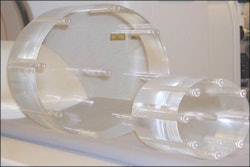Image Gently's new campaign to reduce patient exposure to radiation dose during diagnostic fluoroscopy procedures represents a new milestone for the initiative, which in just three years has made major strides in raising radiation dose awareness among both patients and healthcare providers.
This is the fourth initiative of the Image Gently campaign. Over the past three years, its creator, the Alliance for Radiation Safety in Pediatric Imaging, implemented campaigns to increase awareness of the need to "child-size" radiation dose for CT and interventional fluoroscopy exams and, if possible, to avoid performing unnecessary procedures. Another campaign to promote radiation literacy was targeted at parents and pediatricians.
Founded by the Society for Pediatric Radiology (SPR), the American College of Radiology (ACR), the American Society of Radiologic Technologists (ASRT), and the American Association of Physicists in Medicine (AAPM), the Alliance now includes an additional 58 medical organizations serving more than 500,000 healthcare providers worldwide.
Five organizations have joined the alliance in the past five months: the American Academy of Oral and Maxillofacial Radiology (AAOMR), the Federaal Agentschap voor Nucleaire Controle (FANC) of Brussels, the Illinois State Society of Radiologic Technologists (ISSRT), the Society of Radiographers of London, and the Society of Breast Imaging (SBI).
Through Image Gently, the alliance is working to make both medical professionals and parents aware that any radiation dose exposure from a diagnostic imaging exam may be unnecessary exposure for a child. When radiology procedures are ordered based on clinical appropriateness criteria, the radiation dose used should be as low as diagnostically permissible.
Informational brochures for ordering physicians and for parents and their children are now available in 13 languages. In 2010, translations in Greek, Hebrew, and Polish were added.
At the end of January 2011, the official birthday of the campaign, the Image Gently website had received more than 350,000 visits. Its recommended pediatric CT protocols have been downloaded more than 26,000 times, and 6,505 medical professionals have now taken the Image Gently pledge, an increase of 68% since January 2010.
Pause and pulse initiative
The basic tenets of the diagnostic fluoroscopy campaign are to child-size fluoro technique, step lightly on the fluoroscopy pedal, and, if clinically appropriate, substitute a radiation-free procedure such as an ultrasound or MRI exam.
The international push to lower radiation dose has already spurred innovation in fluoroscopic equipment design, said Marta Hernanz-Schulman, MD, professor of radiology and pediatrics at Vanderbilt University Medical Center in Nashville, TN, and chair of the fluoroscopy campaign.
"Contemporary fluoroscopy systems have considerable dose-saving capabilities, which were not available years ago," she said. "These systems can maintain and sometimes significantly improve image quality while achieving significant reductions in dose."
Radiologists can use numerous techniques to significantly decrease the amount of radiation to which children are exposed, while still providing diagnostic quality images. These include:
- Having a clear initial understanding of the patient's problems and the goals of the imaging exam
- Limiting fluoroscopic time, in general, and limiting use of magnification mode, in particular
- Careful collimation to the area of interest and appropriate shielding
- Matching tube output (kVp and mAs) to the size of the child
- Using pulsed digital fluoroscopic equipment with adjustable frame speeds as well as last image hold and capture capability
"The Image Gently website now makes it possible for radiologists to obtain the most current information they need to stay abreast of new developments," Hernanz-Schulman said. "The Pause and Pulse initiative gives providers real-world, practical guidance to help ensure that the radiation dose administered to children is as low as possible given the particular circumstances of each case."
New information includes a checklist of dose reduction and quality maintenance steps to take in the radiology department, a checklist of dose reduction steps that can be taken for each patient, and a slide presentation for use by providers to teach methods to reduce dose and maintain image quality. Tips for technologists have been developed, as well as information for referring physicians.
Easy-to-understand brochures from the Pause and Pulse initiative for parents and patients can be downloaded and printed. These are currently available only in English, but they are expected to be translated into more languages during 2011.
Hernanz-Schulman pointed out that the Pause and Pulse initiative is also an empowerment campaign for pediatricians and other pediatric specialists. She suggested that these physicians may feel more confident communicating with their radiology colleagues. With the information provided, her committee hopes that physicians planning to order a fluoroscopy exam will ask questions about child-sizing dose, and minimizing the radiation dose of a fluoroscopy procedure without compromising diagnostic quality.
To ensure that a qualified, experienced, and credentialed medical team is performing the fluoroscopic examination using equipment suitable to children, referring physicians and parents are encouraged to ask if the facility is accredited by the ACR, how frequently the facility performs the requested fluoroscopic study in children, if a board-certified radiologist with pediatric experience or a pediatric radiologist will be performing and interpreting the study, and if radiologic technologists are also certified.
"There is no law regulating the amount of radiation a patient receives during a fluoroscopy exam, which is left to the discretion of the person performing the procedure," explained Hernanz-Schulman. "For this reason, fluoroscopies are usually performed by individuals who have had substantial radiation training."
Medical physicists also play in important role. Ishtiaq Hussain Bercha, a medical physicist at the Children's Hospital in Aurora, CO, and the lead medical physicist for the Pause and Pulse initiative, pointed out that medical physicists could help optimize the entire fluoroscopic procedure, especially with respect to radiation safety for both the patient and the caregivers. He emphasized the need to recognize potential radiation exposure to the fluoroscopist, technologist, and any other assisting clinical staff when immobilizing and positioning the patient during a procedure.
"We really need to image our kids with care," concluded Hernanz-Schulman. "This new campaign reminds medical professionals to pause to properly plan and prepare for the study, to activate dose-saving features of equipment, to take no exposures unless necessary, to depress last image hold instead, and to pulse at the lowest possible frame rate."
Information about the Pause and Pulse campaign, developed by an all-volunteer 13-member team of pediatric radiologists, medical physicists, and radiologic technologists beginning in 2008, is now available on the Image Gently website.
By Cynthia E. Keen
AuntMinnie.com staff writer
February 14, 2011



















